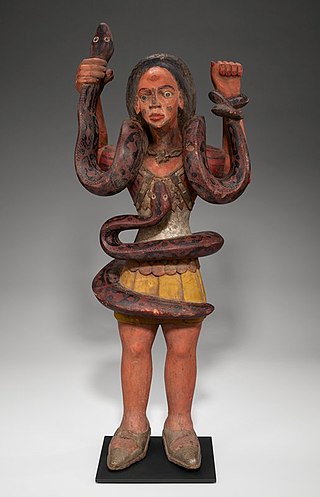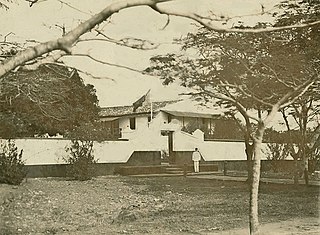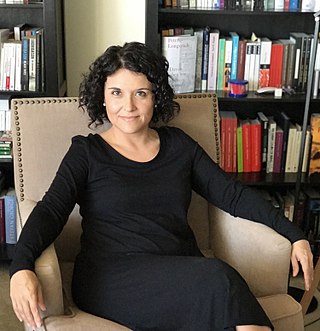
The Kingdom of Dahomey was a West African kingdom located within present-day Benin that existed from approximately 1600 until 1904. It developed on the Abomey Plateau amongst the Fon people in the early 17th century and became a regional power in the 18th century by expanding south to conquer key cities like Whydah belonging to the Kingdom of Whydah on the Atlantic coast which granted it unhindered access to the tricontinental Atlantic Slave Trade.

A Simbi is a Central African water and nature spirit in traditional Kongo religion, as well as in African diaspora spiritual traditions, such as Hoodoo in the southern United States and Palo in Cuba. Simbi have been historically identified as water people, or mermaids, pottery, snakes, gourds, and fire. Due to the forced removal of Bantu peoples from Africa to the Americas, the veneration of simbi exists today in countries, such as the United States, Brazil, Cuba, and Haiti.

Hoodoo is an autonomous ethnoreligion that also expands as a set of spiritual practices, traditions, and beliefs that were created by enslaved African Americans in the Southern United States from various traditional African spiritualities and elements of indigenous botanical knowledge. Practitioners of Hoodoo are called rootworkers, conjure doctors, conjure men or conjure women, and root doctors. Regional synonyms for Hoodoo include rootwork and conjure. As a autonomous spiritual system it has often been syncretized with beliefs from Islam brought over by enslaved West African Muslims, and Spiritualism. Scholars define Hoodoo as a folk religion.

The Slave Coast is a historical region along the Atlantic coast of West Africa, encompassing parts of modern-day Togo, Benin, and Nigeria. It is located along the Bight of Biafra and the Bight of Benin that is located between the Volta River and the Lagos Lagoon.
Ouidah or Whydah, and known locally as Glexwe, formerly the chief port of the Kingdom of Whydah, is a city on the coast of the Republic of Benin. The commune covers an area of 364 km2 (141 sq mi) and as of 2002 had a population of 76,555 people.

The Forte de São João Baptista de Ajudá is a small restored fort in Ouidah, Benin. Built in 1721, it was the last of three European forts built in that town to tap the slave trade of the Slave Coast. Following the legal abolition of the slave trade early in the 19th century, the Portuguese fort lay abandoned most of the time until it was permanently reoccupied in 1865.

The House of Slaves and its Door of No Return is a museum and memorial to the victims of the Atlantic slave trade on Gorée Island, 3 km off the coast of the city of Dakar, Senegal. Its museum, which was opened in 1962 and curated until Boubacar Joseph Ndiaye's death in 2009, is said to memorialise the final exit point of the slaves from Africa. While historians differ on how many African slaves were actually held in this building, as well as the relative importance of Gorée Island as a point on the Atlantic slave trade, visitors from Africa, Europe, and the Americas continue to make it an important place to remember the human toll of African slavery.

Francisco Félix de Souza was a Brazilian slave trader who was deeply influential in the regional politics of pre-colonial West Africa. He founded Afro-Brazilian communities in areas that are now part of those countries, and went on to become the "chachá" of Ouidah, a title that conferred no official powers but commanded local respect in the Kingdom of Dahomey, where, after being jailed by King Adandozan of Dahomey, he helped Ghezo ascend the throne in a coup d'état. He became chacha to the new king, a curious phrase that has been explained as originating from his saying "(...) já, já.", a Portuguese phrase meaning something will be done right away.

The Kingdom of Benin, also known as Great Benin or Benin Kingdom is a kingdom within what is now southern Nigeria. It has no historical relation to the modern republic of Benin, which was known as Dahomey from the 17th century until 1975. The Kingdom of Benin's capital was Edo, now known as Benin City in Edo State, Nigeria. The Benin Kingdom was "one of the oldest and most developed states in the coastal hinterland of West Africa". It grew out of the previous Edo Kingdom of Igodomigodo around the 11th century AD, and lasted until it was annexed by the British Empire in 1897.

Manuel Mendive Hoyos is an Afro-Cuban artist.

The Dutch Slave Coast refers to the trading posts of the Dutch West India Company on the Slave Coast, which lie in contemporary Ghana, Benin, Togo, and Nigeria. The primary purpose of the trading post was to supply slaves for the Dutch colonies in the Americas. Dutch involvement on the Slave Coast started with the establishment of a trading post in Offra in 1660. Later, trade shifted to Ouidah, where the English and French also had a trading post. Political unrest caused the Dutch to abandon their trading post at Ouidah in 1725, now moving to Jaquim, at which place they built Fort Zeelandia. By 1760, the Dutch had abandoned their last trading post in the region.
Beninese American are Americans of Beninese descent. According to the census of 2000, in the United States there are only 605 Americans of Beninese origin. However, because since the first half of the eighteenth century to nineteenth many slaves were exported from Benin to the present United States, the number of African Americans with one or more Beninese ancestors could be much higher. The number of slaves from Bight of Benin exported to present United States exceeded 6,000 people, although this might consist not only in Benin, but also washes the shores of Ghana, Togo and Nigeria. It is also important to note that they were slaves from modern Benin, who exchanged voodoo practices with Francophone African descendants in Louisiana. Currently, there are Beninese communities in cities such as Chicago or Washington, D.C., Philadelphia and in other states as New York. As of 2021, there were over 500 Beninese immigrants in the town of Austin, Minnesota.
Yoruba Americans are Americans of Yoruba descent. The Yoruba people are a West African ethnic group that predominantly inhabits southwestern Nigeria, with smaller indigenous communities in Benin and Togo.
Julien Sinzogan, is a Beninese contemporary painter and graphic artist. His artwork actively engages the impact of the Atlantic Slave Trade on his native Benin, one of the largest slave-trading posts of West Africa. He has exhibited widely throughout Europe and Africa. As a professional artist Sinzogan's techniques and references move from areas of monochrome pen and ink into glimpses of full-color scenes. He lives in Paris, France.

Ana Lucia Araujo is an American historian, art historian, author, and professor of history at Howard University. She is a member of the International Scientific Committee of the UNESCO Slave Route Project. Her scholarship focuses on the transnational history, public memory, visual culture, and heritage of slavery and the Atlantic slave trade.

Vodun art is associated with the West African Vodun religion of Nigeria, Benin, Togo and Ghana. The term is sometimes used more generally for art associated with related religions of West and Central Africa and of the African diaspora in Brazil, the Caribbean and the United States. Art forms include bocio, carved wooden statues that represent supernatural beings and may be activated through various ritual steps, and Asen, metal objects that attract spirits of the dead or other spirits and give them a temporary resting place. Vodun is assimilative, and has absorbed concepts and images from other parts of Africa, India, Europe and the Americas. Chromolithographs representing Indian deities have become identified with traditional Vodun deities and used as the basis for murals in Vodun temples. The Ouidah '92 festival, held in Benin in 1993, celebrated the removal of restrictions on Vodun in that country and began a revival of Vodun art.
The International Festival of Vodun Arts and Cultures, also known as the Ouidah Festival, was first held in Ouidah, Benin in February 1993, sponsored by UNESCO and the government of Benin. It celebrated the transatlantic Vodun religion, and was attended by priest and priestesses from Haiti, Cuba, Trinidad and Tobago, Brazil and the United States, as well as by government officials and tourists from Europe and the Americas. The festival was sponsored by the newly elected president of Benin, Nicéphore Soglo, who wanted to rebuild the connection with the Americas and celebrate the restoration of freedom of religion with the return to democracy. Artists from Benin, Haiti, Brazil and Cuba were given commissions to make sculptures and paintings related to Vodun and its variants in Africa and the African diaspora.
Dominique "Kouas" Gnonnou is a contemporary Beninese artist and sculptor of Vodun art.
Simonet Biokou is a contemporary Beninese scrap metal artist. He has also appeared in film, playing himself in the 1998 film Divine Carcasse, in which his character is shown creating a sculpture using car parts. His works have been featured in major metropolitan museums including the Metropolitan Museum in New York.
Yves Apollinaire Pede (1959–2019) was a Beninese voodoo artist. After being commissioned to reproduce reliefs for the Abomey Museum, he made sand paintings of well-known personalities such as Nelson Mandela. He gradually became oriented towards textile art, looking to Haitian and Cuban Vodou artists for inspiration. He is also noted for his large cement sculptures and bas-reliefs, and is stated to have a "special interest" in Kulito, a Fon word which literally means "the one from the path of death".












